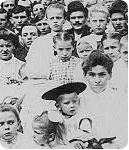Eugene V. Debs, arguably the foremost union activist in American history, described the 1909 McKees Rocks, Pa., strike this way: "The greatest labor fight in all my history in the labor movement." Yet today, few remember this struggle when immigrant workers rose up and changed the course of American unionism.

The strike took place at the huge Pressed Steel Car Co. plant in McKees Rocks, a few miles down the Ohio River from Pittsburgh, where between 5,000 and 8,000 mostly immigrant workers from some 16 nationalities created railway cars. Hailing mainly from southern and eastern Europe, they included "Russians who had served in the 1905 Duma [parliament], Italians who had led resistance strikes, Germans who were active in the metal workers' union," according to historian Sidney Lens. "But because of the language barrier they were easily divided, and thoroughly exploited."
At McKees Rocks, "exploited" literally meant daily injuries and deaths. Labor historian Charles McCollester quotes from an article in the Pittsburgh Leader, one of the city's daily newspapers, which reported that when a worker is maimed and mangled in his work, "some foreman or other petty 'boss' pushes the bleeding body aside with his foot to make room for another living man, that no time be lost in the turning out of pressed steel cars. The new man often works for some minutes over the dead body until a labor gang takes it away." A former county coroner testified that the death toll averaged one person a day.
The workers also were subjected to a corrupt "pool system" in which their pay was determined not by any established wage rate but by the whim of the foremen. On July 10, 1909—a payday—workers received less pay than normal and 40 riveters told the company they wouldn't work unless they were told the pay rates. When they returned to work three days later, they were fired. That was the breaking point. Within 48 hours, 5,000 workers went on strike.
When management brought strikebreakers to the plant on a steamer along the Ohio River, strikers fired their rifles at the steamer and it fled to the opposite shore. Soon, there were more skirmishes when the company brought in hundreds of deputy sheriffs and state constables. One striker was killed at the plant entrance, and 5,000 mourners marched in his funeral procession.
The Pressed Steel Car workers received welcome support from other workers. Railway trainmen on lines leading into the city and the motormen on the local streetcar lines all refused to haul scabs. This solidarity was critical. In the end, the workers won what Lens called "a victory of towering proportions." As he recounted, management "agreed to end the pool system, raise wages by an immediate 5 percent and 10 percent more in 60 days, fire the remaining scabs and rehire all strikers."
The victory at McKees Rocks extended well beyond the plant. This was the moment when immigrant workers who had no power—"persecuted, robbed, and slaughtered," as one local priest described them—found their voice. The turning point may have come at a giant rally on Indian Mound, a hill near the Ohio River, when 8,000 workers joined together and heard fiery speeches in nine languages. After that, they and the union movement itself were never the same.
Eugene Debs correctly interpreted the workers' victory. He predicted the McKees Rocks success would be "a harbinger of a new spirit among the unorganized, foreign-born workers in the mass production industries who can see here in McKees Rocks the road on which they must travel—the road of industrial unionism."
Sources
McCollester, Charles, The Point of Pittsburgh. Battle of Homestead Foundation, 2008. Brody, David, Steelworkers in America: The Nonunion Era. Harper & Row, 1969. Lens, Sidney, The Labor Wars: From the Molly Maguires to the Sit-Downs. Haymarket Books, 2008.

